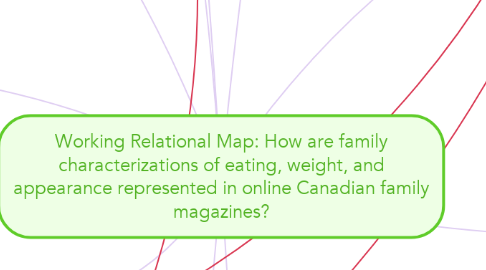Working Relational Map: How are family characterizations of eating, weight, and appearance represented in online Canadian family magazines?
by Wendy Salvisberg

1. Individual Human Elements
1.1. Dieticians/ nutritionists
1.2. Physicians
1.3. Psychologists/ psychiatrists
1.4. Teachers/ professors
1.5. Chefs
1.6. Food writers
1.7. Entrepreneurs
1.8. Photographers
1.9. Fitness instructors
1.10. Mothers
1.11. Children and adolescents
1.12. Survivors of eating disorders
2. Non-Human Elements
2.1. ParentsCanada magazine
2.2. Today’s Parent magazine
2.3. Canadian Family magazine
2.4. Canadian Living magazine
2.5. Readers Digest magazine
2.6. Canada Food Guide
2.7. Internet
2.8. Online articles
2.9. Researcher journal
2.10. Researcher memos
2.11. Consultation with supervisors
2.12. Emails
2.13. OurKids.net
2.14. Mindmeister.com
2.15. Gliffy.com
3. Collective Human Elements
3.1. Families
3.2. Obesity Society
3.3. Society of Obstetricians and Gynaecologists of Canada
3.4. Canadian Medical Association
3.5. House of Commons Standing Committee on Health
3.6. Health Canada
3.7. Weight Watchers
3.8. EatRight Ontario
3.9. Perinatal Resource Center of Montréal
3.10. Statistics Canada
3.11. Body Image Works
3.12. Canadian Organic Growers
3.13. Children’s Environmental Health Network
3.14. Real Food for Real Kids
3.15. FoodShare Toronto’s Salad Bars in Schools
3.16. Slow Food Movement
3.17. Canadian Personal Chef Association
3.18. Dieticians of Canada
3.19. Canada’ Physical Activity Guide
3.20. Active Healthy Kids Canada
3.21. ParticipAction
3.22. Heart and Stroke Foundation
3.23. Canadian Diabetes Association
3.24. Sprout Right
3.25. Centers for Disease Control and Prevention
4. Sociocultural Elements
4.1. Media
4.2. Family pressure
4.3. Peer pressure
5. Major Issues/ Debates
5.1. Restrictive eating practices versus listen to your body
5.2. Health over weight
5.3. Measures of health
5.4. Weight as a problem
5.5. Appearance tied to body shape
5.6. Body acceptance
5.7. Extending the focus beyond appearance
6. Spatial Elements
6.1. Universities/ schools
6.2. Hospitals/ health clinics
6.3. Family home environment
7. Implicated/ silent elements
7.1. Eating for health
7.2. Definitions of ‘appropriate’ eating behaviours
7.3. Balanced diet
7.4. Definitions of health
7.5. Weight-related concerns impact on wellness/ wellness impact on weight-related concerns
7.6. Beauty at every size
7.7. Weight loss/ weight management
7.8. Weight bias
7.9. Fathers
8. Family Characterizations of Eating Discourses
8.1. Portion control
8.2. Count calories
8.3. Food restriction
8.4. Food tracking
8.5. Appetite control
8.6. Food avoidance
8.7. Listen to hunger and satiety signals
8.8. Division of Responsibility in Healthy Eating
8.9. Quantity of food depends on the individual
8.10. Rigid eating practices
8.11. Timed meals
8.12. Eating/ meal routines
8.13. Eliminate distractions during meals
8.14. Flexible eating practices
8.15. Make eating fun
8.16. Follow the Canada Food Guide
8.17. Eliminate unhealthy foods
8.18. Organic versus non-organic food
8.19. Read food labels
8.20. Balanced diet
8.21. Moderate approaches to healthy eating
8.22. Healthy alternatives
8.23. Eating for pleasure
8.24. Eating for energy
8.25. Home cooked meals
8.26. Creative meal preparation
8.27. Transparency of healthy food presentation
8.28. Connection between eating and emotion
8.29. Healthy eating is simple
8.30. Manners
8.31. Meals to foster family connection
8.32. Shared meal preparation
8.33. Shared meals
8.34. Avoid conversations about food
8.35. Avoid encouraging children to diet
8.36. Unhealthy eating behaviours contributes poorly to wellness
8.37. Negative influence of under-eating on wellness
8.38. Positive influence of healthy eating on wellness
8.39. Positive influence of shared meal preparation responsibility within the family on wellness
9. Family Characterizations of Weight Discourses
9.1. Health over weight
9.2. Numerical measures of weight
9.3. Ignore numerical measures of weight
9.4. Healthy at every size
9.5. Skinny equals healthy
9.6. Overweight or obese associated with poor health
9.7. Obesity epidemic
9.8. Weight-related statistics
9.9. Increasing rates of child obesity and overweight
9.10. Children and adolescents at risk for body image concerns
9.11. Symptoms of eating disorders
9.12. Pathologizing weight-related labelling
9.13. Gender-specific weight-related concerns
9.14. Confusing weight-related information in the media
9.15. Weight-related concerns are misunderstood
9.16. Education on weight-related concerns not helpful
9.17. Education on weight-related concerns helpful
9.18. Physicians as advocates for weight loss
10. Family Characterizations of Appearance Discourses
10.1. Devaluation of fat
10.2. Thinness is attractiveness
10.3. A thin mom is a good mom
10.4. Appearance tied to body shape
10.5. Appearance-related commentary (not associated with weight)
10.6. Acceptance of all shapes and sizes
10.7. Promotion of positive body image
10.8. Avoidance of commentary based on appearance
10.9. The human body is capable
10.10. Commentary based on strengths, abilities, skills and characteristics
11. Other Discourses
11.1. Parents as health promoters
11.2. Provide support
11.3. Parents as role models of healthy weight-related behaviours
11.4. Importance of home environment for child health
11.5. Positive influence of parent-child relationships on mental health
11.6. Pressure on parents to be promoters of health
11.7. Parents as ‘preventors’ of weight-related concerns
11.8. Parents as role models of unhealthy weight-related behaviours
11.9. Children as observational learners of weight-related behaviours
11.10. Health as a lifestyle
11.11. Promotion of exercise for health
11.12. Exercise as a component of a healthy lifestyle
11.13. Lack of physical activity contributes poorly to wellness
11.14. Media literacy
11.15. Teachers as health promoters
11.16. Health promotion campaigns oriented towards youth
11.17. Involvement of others in child wellness
11.18. Adolescent vulnerability to sociocultural pressures
11.19. Influence of media on wellness
11.20. Influence of peers on physical health
11.21. Exercise as a skill
11.22. Exercise for family bonding


